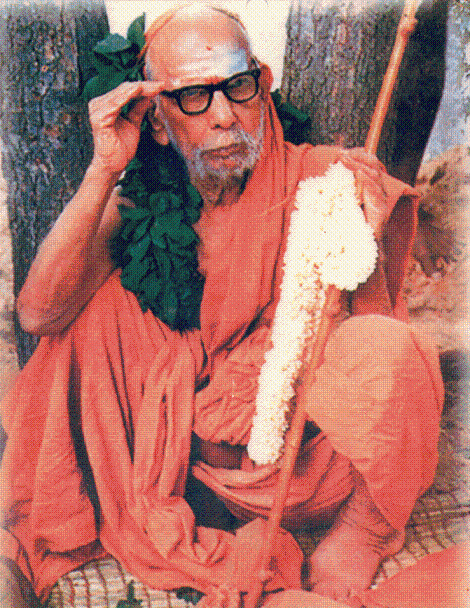
|
|
||||||||||||||||||||||
| His Holiness Jagadguru Shankaracharya Shri Chandrashekarendra
Saraswati Swamigal (May 20, 1894–January 8, 1994) or the Sage of
Kanchi was an Indian Saint. He is usually referred to as Shri
Chandrashekarendra Saraswati or Paramacharya or MahaSwami or
Maha Periyavaal. Early life Mahaswami Chandrashekarendra saraswathi was born on 20 May 1894, under Anuradha star according to the Hindu calendar, into a Kannadiga Smartha Hoysala Karnataka Brahmin family in Viluppuram, South Arcot District, Tamil Nadu as Swaminatha. He was the second son of Subramanya Sastri, a District Education Officer. The child was named Swaminatha, after the family deity, Lord Swaminatha of Swamimalai, near Kumbakonam. Swaminatha began his early education at the Arcot American Mission High School at Tindivanam, where his father was working. He was an exceptional student and excelled in several subjects.[citation needed] He won a prize for his proficiency in the recitation of the "Holy Bible". In 1905, his parents performed his Upanayanam, a Vedic ceremony which qualifies a Brahmin boy to begin his Vedic studies under an accomplished teacher. Incidents leading to Sainthood During the childhood of the Acharya, his father consulted an astrologer who, upon studying the boy's horoscope, is said to have been so stunned that he prostrated himself before the boy exclaiming that "One day the whole world will fall at his feet."[citation needed] In 1906, the 66th Acharya of Sri Kanchi Kamakoti Peetham performed the annual Chaturmasyam (a forty-day annual ritual performed by Hindu ascetics while remaining in one place), in a village near Tindivanam in Tamil Nadu. This was Swaminathan’s first exposure to the Math and its Acharya. Later, Swaminathan accompanied his father whenever he visited the Math where the Acharya was deeply impressed by the young boy. In the first week of February 1907, the Kanchi Kamakoti Math had informed Subramanya Sastrigal that Swaminathan's first cousin (son of his mother's sister) was to be installed as the 67th Peetathipathi. The presiding Acharya was then suffering from smallpox and had the premonition that he might not live long. He had, therefore, administered upadesa to his disciple Lakshminathan before he died. Sastrigal being away in Trichinopoly on duty arranged for the departure of Swaminathan with his mother to Kanchipuram. The boy and his mother started for Kalavai (where Lakshminathan was camping) to console his aunt who, while also being a widow, had just given up her only son to be an ascetic. They traveled by train to Kanchipuram and halted at the Sankara Math. By then, Lakshminathan had fallen ill: I had a bath at the Kumara Koshta Tirtha. A carriage of the Math had come there from Kalavai with the people to buy articles for the Maha Puja on the tenth day of the passing of the previous 66th Acharya. One of them, a hereditary maistry (mason) of the Math, asked me to accompany him. A separate cart was engaged for the rest of the family to follow me. During the journey the maistry hinted to me that I might not return home and that the rest of my life might be spent in the Math itself. At first I thought that my elder cousin having become the Head of the Math, it was his wish that I should live with him. But the maistry gradually clarified matters as the cart rolled on. The acharya had fever which developed into delirium and that was why I was being separated from the family to be taken to Kalavai... I was stunned by this unexpected turn of events. I lay in a kneeling posture in the cart, shocked as I was, repeating "Rama... Rama," the only prayer I knew. My mother and other children came some time later only to find that instead of her mission of consoling her sister, she herself was placed in the state of having to be consoled —T.M.P. Mahadevan,
The Sage of Kanchi The 67th Acharya also died, after reigning for a brief seven
days as the head of the Math. Swaminathan was immediately
installed as the 68th head of the Kanchi Kamakoti Peetam on
February 13, 1907, the second day of the Tamil month of Masi,
Prabhava year. He was given Sanyasa Asramam at the early age of
13 and was named Chandrasekharendra Saraswati. On May 9, 1907
his "Pattabishegam" as the 68th Peetathipathi of Kanchi Kamakoti
Peetam was performed at the Kumbakonam Math. Devotees including
Shivaji Maharaja of Tanjore, government officials and pundits
participated in the event. |
||||||||||||||||||||||
